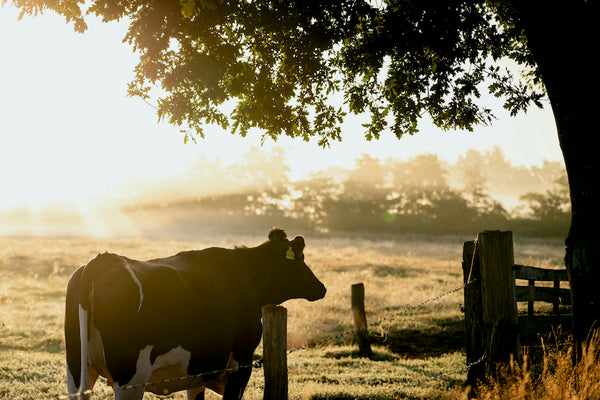
Get news, updates, & event Info delivered right to your inbox:
How Do Agriculture and Climate Change Impact Food Security?
As the effects of climate change become more profound and observable, it’s worth taking a close look at how agriculture and climate change impact each other — and what we can do about it. The top 3 greenhouse gases that drive climate change are carbon dioxide (CO2), methane (CH4), and nitrous oxide (N2O). We also know they’re all emitted by the activities of the agricultural sector.
In 2022, the US EPA reported that the agricultural sector was responsible for 10% of the country’s greenhouse gas emissions that year, representing an 8% increase from 1990. While this is lowest of the top 5 greenhouse gas emitters in the United States, it represents a significant emissions contribution.
Globally, that percentage is slightly higher, with the World Resources Institute (WRI) estimating that agriculture accounted for a cumulative 12.3% of greenhouse gas emissions in 2020.
The science is clear: the food we eat and the ways we produce it are significantly contributing to the climate crisis. To stop compounding the problem, we must reduce our greenhouse gas emissions from the agriculture sector — and we must do it soon.
Climate Change and Animal Agriculture: How They’re Connected
We’re sure you’ve heard that cows produce methane, and while the average meat carbon footprint can be substantial, there’s actually a lot more to it than that. Meat producers clear vast swaths of forest (sometimes by starting forest fires) to graze their livestock, and give them specialized feed to prepare them for the market — in fact, 70-75% of all soybeans grown go directly into feed for cattle, poultry, pigs, and farmed fish.
On our current trajectory of population growth, there will be around 10 billion people on the planet by 2050. Without any increase in productivity, the World Resources Institute found that we would need an additional 593 million hectares (or two Indias) of global agricultural land area to feed the world.

A recent study by the University of Oxford found that people that eat a plant-based diet produce approximately 75% less greenhouse gas emissions than those who consume more than 3.5 ounces of meat a day. Growing food for a vegan diet is also significantly less harmful to land, water and biodiversity.
The study also found that people who follow vegetarian, pescatarian, or low meat diets have a significantly lower environmental impact. For example, study participants who consumed only 1.7 ounces of meat accounted for about half the amount of daily carbon dioxide emissions than those that consumed 3.5 ounces. In other words? Dietary changes can and do make a significant impact.
How Agriculture Affects Climate Change
A few ways that agriculture contributes to climate change are:
- Degrades soils by planting monocultures, relying on synthetic fertilizer, and tilling fields regularly
- Reduces diversity by transforming landscapes from biodiverse ecosystems to monocultural fields
- Pollutes the land by relying heavily on fertilizers and pesticides.
- Releases greenhouse gasses, primarily through soil management, livestock digestive processes, manure management, and other practices.
- Significantly contributes to global deforestation, which triggers the release of carbon stored in trees.

Effects of Climate Change on Agriculture
Our existing agricultural practices place a tremendous burden on nature, leaving a farmers highly susceptible to climate change impacts such as:
- Changing precipitation patterns
- Changing temperature patterns
- Extreme weather events like floods and droughts
- Reduced crop and livestock viability
- Proliferation of pests, pathogens, and migrating weeds that outcompete native crops
As a result, farmers — who are on the frontlines of climate change — will increasingly face grueling and potentially unsafe conditions, accelerated crop failures and livestock losses, threatened livelihoods as profits are lost and farms fail, reduced water supplies, and more.
And as they say, No Farms, No Food: while farms struggle to keep the lights on, consumers will feel the effects of a destabilizing food supply — like higher prices and decreased food security. This ripple effect will extend beyond our dinner plates, though, affecting national and international markets for fiber, bioenergy, and other farmed products.

How We Can Transform the Food System
Farmers are the lifeblood of any nation, and supporting them, food workers, and rural economies to adapt their practices and increase resilience is important for more than just climate change mitigation. The good news is that there are plenty of science-backed solutions and we can work with farmers to transform our agricultural system, reduce greenhouse gas emissions, sequester carbon, support biodiversity, rebuild our soils, and more. These include:
- Building healthy, “spongy” soils that capture and store water and carbon through practices like planting cover crops and deep-rooted perennials
- Helping farmers increase their resilience and transform farms into diverse agro-ecosystems by planting native trees and plants where appropriate
- Selecting and developing crop varieties and livestock breeds that are more resilient to variable climate conditions
- Reducing food waste (if food waste were a country, it would be the third largest emitter of greenhouse gases after the U.S. and China)
- Phasing out damaging pesticides and fertilizers by integrating sustainable farming practices
- Supporting women’s farming cooperatives — study after study has shown that investing in women benefits the entire community
- Reducing our consumption of factory farmed meat and supporting local, pasture-raised meat producers
- Supporting sustainable agroforestry projects around the world, and more!
Transforming our agricultural system is a big task for an already struggling industry, but it’s just as essential to managing the climate crisis as planting trees.
Just as we need to restore forests through an integrated approach of conserving existing ecosystems, restoring degraded ones, and supporting reforestation where it’s needed, we must also take a multi-layered approach to leveling up our food systems to face the challenges of the 21st century. By supporting our farmers as they transition to the integrated, sustainable practices necessary to feed a warming planet, we can accomplish that and so much more.
Want to make a difference right now? Plant trees today!
